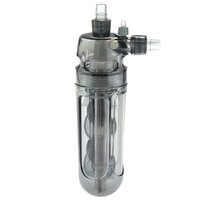I spent many a day experimenting with DIY reactors, some worked very well, some worked for me but not for others who tried the same designs!
There are so many variables that can effect performance, size on tank, amount of flow, amount of C02, power of pump etc....
However the basic principle is ..... to maintain a contact time between the gas bubbles and the tank water that is long enough to completely dissolve the C02.
In theory, a simple tube would do the job but it would need to be very long.
If you can spin the water inside the tube then the travel time increases, if you can form a vortex then the contact time will increase tenfold over and over again!
Another way, would be to restrict the C02 path by adding bio balls or similar, a further improvement would be to place the C02 against the flow of water.
This is the most popular method that commercial reactors use but, that method will obviously reduce flow.
The main problem with a DIY vortex revolves around finding a suitable vessel and finding a way to spin the water.
The inlet and outlet would ideally enter the vessel at an extream tangent and that is not east to DIY.
What we need is a large company to produce a suitablely sized, clear, vortex reactor that won’t reduce flow to much.
I posted this thread a few years back now
https://www.ukaps.org/forum/threads/high-flow-diy-reactor-now-with-video.23337/ the reactor still works extreamly well although it is opaque now.
However the vessel is not a common size and the new under sink water filters are quite a bit smaller.
Here is the video but I can’t seem to get a live embedded link?
https://m.youtube.com/watch?feature=plcp&v=vgt3COKNIqg


